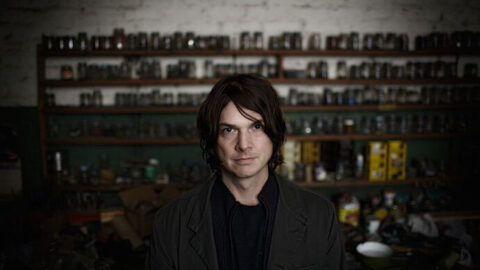“Here is your audience instrument; you take it apart like chopsticks,” said the usher, handing me a couple of glued-together jagged pieces of wood along with my concert program. Audience participation, oh my. This concert was either going to be very good or, more likely, very silly.
Luckily, my expectations were completely upended when Glenn Kotche’s Wild Sound (2014) turned out to be one of the rare new music experiences that effectively integrates visuals, sounds, movement, narrative, and theatricality in the conveyance of what Kotche describes as “a history of human ingenuity.” Wild Sound was presented at the Met Museum on May 29, 2015 by Third Coast Percussion in one of the most fluid and remarkable performances I’ve witnessed.
It began with the four members of Third Coast Percussion (Sean Connors, Robert Dillon, Peter Martin, and David Skidmore) hauling industrial buckets of wood onto the stage, which was already playing home to work tables and found objects including an upside-down bicycle. At first there was no distinguishable organization of rhythm or patterns as the musicians broke pieces of wood in half and a soft male voiceover intoned calmly over the sounds of birds chirping and foliage rustling. Eventually, the sounds of packing tape ripped over and over, along with sand shaking and drumsticks scuttling along the wheels of the bicycle, settled into an aggregate of repeating rhythmic fragments, laying the foundation for the many rotations and combinations of textures and timbres that were to come. The percussionists literally and figuratively constructed assemblages of sounds and ideas against a prerecorded audio background of wind chimes and the occasional cow mooing. The visual backdrop proved to be equally peaceful, as the towering projections of grass and flowers fluttering in a breeze managed not to be distracting or overbearing. The eventual shift from images of nature to those of colorful, overlapping construction beams didn’t feel contrived, but rather, earned through the deftness of Kotche’s unique brand of storytelling.

Similarly, the music went through interchanges in mood and texture that felt like an organic progression rather than a formulaic (or, conversely, haphazard) evolution. At various junctures in the piece, the musicians sawed pieces of wood, thwacked yardsticks against a work table, hung up metal squares like sheets on a laundry line and used them as chimes, drummed flower pots, and drew out audience participation as they encouraged us to clap and pat and rub our hands and eventually to rip apart our “chopsticks” and scrape them together (and most of us were good sports about it). There was never enough time to get bored or even acclimatized: the little bits of melody from the pots and plates were still echoing in my brain when rips and saws and bowls of rocks and the occasional unidentifiable whoo or whir interjected across my ears. Towards the end, the buzz of drills and other power tools grew louder and more distorted but quickly dissolved into the last section.
In this wondrous final symphony of sights and sounds, the musicians abandoned the toolboxes and workbenches as the hallucinatory beams of the video projection teetered and toppled behind them. On the darkened stage, the percussionists retreated behind four identical devices that looked like wires arranged in the shape of menorahs within glass cases, but which are actually keyboards using arduino technology (a physical computing platform used to develop interactive objects), developed by the engineering department at the University of Notre Dame. Eight white gloves moved in different patterns as forty fingertips–using the metal filaments sewn into the gloves–sounded out Kotche’s melodies and harmonies. The final single-note melody once again felt suitably earned rather than tacked on or conceded. The blueprint of Wild Sound manages to feel scrupulously intricate while “still leaving room for the unplanned and unexpected,” as Kotche intended. Needless to say, the transformation from the sawdust beginnings to this open-source-programmed ending took “process music” to a whole new level.

Speaking of which, Wild Sound had followed a program of smaller-scale percussion works, including David Cossin’s 2007 arrangement of Steve Reich’s Music for Pieces of Wood (1973) for two drumkits. Kotche and David Skidmore gave a hypnotically powerful performance; this followed Kotche’s equally impressive solo performances of Joao Gilberto’s Undiu (1973) and his own work, Projections of (What) Might (2006). And of course, Third Coast Percussion had started off the program playing an instrument even more unusual than buckets or flower pots: a 125-year-old rock harmonicon from the Met Museum’s collection. Kotche explained that when asked to choose an instrument on which to compose a piece for this concert–Stones Flow (2015)–he picked the rock harmonicon because it wasn’t “off limits” and because it was pitched. The sonorous stones, which likely had gone unheard since the nineteenth century, sounded in repetitious overlapping patterns, like a cooing Reichian lullaby. The rumble of Kotche’s electronics contributed layers of color and sound that added density to the piece, but couldn’t save it from seeming overall fairly cutesy and, compared to Wild Sound, inconsequential. To be fair, it would probably be difficult to compose something of substance for an irreplaceable musical artifact. Better to save those sorts of endeavors for packing tape and two-by-fours.
























